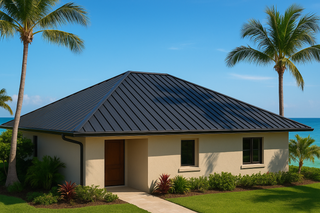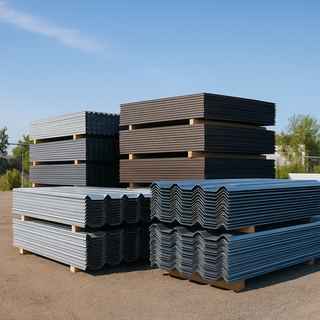Metal roofing is known for its strength, longevity, and low maintenance—but when you're near the ocean, those benefits hinge entirely on one thing: how well your roof withstands salt, humidity, and wind.
Coastal environments are uniquely harsh. From airborne salt particles that corrode exposed materials, to hurricane-force winds and excessive UV exposure, the wrong metal roof system can fail in a matter of years. That’s why it’s essential to choose not only the right metal type, but also the correct coating, fasteners, and installation techniques for long-term protection.
At Top Tier Metals, we specialize in premium roofing products built for extreme conditions. In this guide, we break down everything homeowners and contractors need to know about metal roofing in coastal zones—what works, what doesn’t, and how to make it last for decades.
1. What Makes Coastal Environments So Harsh?
| Coastal Factor | Impact on Roofing |
|---|---|
| Salt-laden air | Accelerates corrosion, especially on unprotected steel |
| High humidity | Promotes rust, mold, and mildew |
| Frequent rain and storms | Causes leaks, panel separation, and flashing failure |
| Hurricane-force winds | Lifts panels, tears underlayment, rips off ridge caps |
| Intense UV exposure | Fades paint, damages coatings, warps fasteners |
Key takeaway: Without the right materials and engineering, even premium metal roofs can degrade quickly in salt-heavy, high-humidity areas.
2. Best Types of Metal for Coastal Roofs
Not all metals handle corrosion equally. Here’s how they stack up in marine environments:
A. Aluminum – ★★★★★ Best Choice
-
Naturally rust-proof (does not contain iron)
-
Extremely lightweight
-
Excellent in high humidity and salt air
-
Often used in boat building and coastal construction
Best Use: Homes within 1 mile of the coast or beachfront properties
B. Stainless Steel – ★★★★☆
-
Corrosion-resistant due to chromium content
-
Heavier and more expensive than aluminum
-
Suitable for structural elements or decorative trim
Best Use: Modern homes or commercial buildings with exposed metal accents
C. Galvalume-Coated Steel – ★★★☆☆
-
Zinc/aluminum alloy coating on steel core
-
Offers decent corrosion resistance (better than galvanized)
-
Not ideal for direct salt exposure
Manufacturer Note: Galvalume is not warrantied within 1,000 feet of saltwater in many cases
Best Use: Properties 1–3 miles from the shoreline, with limited direct salt spray
D. Galvanized Steel – ★★☆☆☆
-
Zinc coating over steel
-
Prone to white rust and red rust in coastal zones
-
Shorter lifespan near oceans
Best Use: Inland applications or areas with low salt concentration
3. Protective Coatings That Matter
Beyond metal type, the paint or coating system is critical in coastal environments.
PVDF (Kynar 500®) – ★★★★★
-
High-performance resin-based coating
-
Offers unmatched UV, fade, and salt resistance
-
Maintains color and gloss for decades
-
Self-cleaning properties reduce salt buildup
Top Tier Standard: All our premium coastal panels come with a PVDF finish
SMP (Silicone-Modified Polyester) – ★★☆☆☆
-
Less expensive, but lower corrosion and fade resistance
-
More prone to chalking and color shift
Recommendation: Avoid SMP in coastal applications—even 5+ miles inland
Clear Coats for Bare Metals
-
Used for copper or stainless steel roofing
-
Helps slow patina and salt aging, but not a replacement for proper alloys
4. Panel Design and Seam Type in Salt Air
Best Design: Standing Seam (Double Lock or Snap Lock)
-
No exposed fasteners
-
Clean vertical seams allow water to drain rapidly
-
Less risk of wind uplift and salt buildup in overlaps
Avoid: Exposed fastener panels (like R-panels) unless rated and treated for coastal use
Why exposed fasteners fail:
-
Screws rust, causing leaks
-
Salt collects around fasteners
-
UV and thermal movement wear out rubber washers
5. Choosing the Right Fasteners
The metal you use is only as strong as what holds it down.
| Fastener Type | Rating for Coastal Use |
|---|---|
| 304/316 Stainless Steel | ✅ Excellent corrosion resistance |
| Zinc-coated/Galvanized | ❌ Rapid corrosion from salt exposure |
| Aluminum (with aluminum roof) | ✅ Great match for coastal aluminum systems |
| Concealed clips | ✅ Ideal with standing seam to eliminate penetrations |
Important: Use butyl tape or high-performance sealant around all roof penetrations (vents, skylights, chimneys)
6. Best Underlayment and Barrier Systems
Even the best metal roof needs a watertight backup system.
Coastal Underlayment Checklist:
-
High-temp synthetic underlayment (at least 260°F rating)
-
Peel-and-stick waterproof membrane at valleys, hips, and ridges
-
Vapor barrier if attic insulation may absorb moisture
-
Proper ventilation to prevent condensation under panels
7. Flashing and Edge Detailing for Salt Air
Salt water works its way into tiny crevices—proper flashing matters.
Best Practices:
-
Use stainless steel or aluminum flashing
-
Ensure all trim has hemmed edges to prevent water ingress
-
Overlap flashing sections by at least 6 inches with sealant
-
Close off ridge ends with end caps or storm baffles
8. Wind Ratings and Installation in Hurricane Zones
In coastal states like Florida, Texas, and the Carolinas, wind uplift is just as big a concern as salt exposure.
What to Look For:
-
Panels with UL 90 / Miami-Dade wind uplift ratings
-
Fastener systems spaced per local code (often 12–18" OC)
-
Ridge cap anchors and starter strips mechanically fastened
-
Consider a continuous cleat system for the strongest hold
9. Routine Maintenance in Salt Zones
Coastal metal roofs do require light maintenance to remain in top shape.
Biannual Checklist:
-
Rinse roof with fresh water to remove salt (garden hose only)
-
Inspect seams and fasteners for corrosion or movement
-
Clear debris from valleys and gutters
-
Check for chalking or fading in paint finish
-
Reapply sealants around vents and penetrations every 5–10 years
10. Warranties and Distance-from-Shore Requirements
Most manufacturers have “coastal restrictions” buried in their warranty documents.
| Distance from Coast | Metal/Coating Requirements | Warranty Eligible? |
|---|---|---|
| 0–1,000 ft (Direct Salt Spray) | Aluminum or 316 Stainless + PVDF | ✅ If certified install |
| 1,000 ft – 1 mile | Galvalume + PVDF or Aluminum | ✅ (May be limited) |
| 1–3 miles | Galvalume with strong barrier coating | ✅ Standard |
| 3+ miles | Any standard metal roof system | ✅ Full coverage |
Top Tier Tip: Always register your warranty with proof of install photos and property location for full coverage.
Final Thoughts: Building Coastal Resilience with Metal Roofing
A coastal home deserves a roof that can take the heat—and the salt. Whether you’re steps from the shore or just inside the salt belt, the right metal, coating, and system design will keep your home safe, dry, and beautiful for 40+ years.
At Top Tier Metals, we help homeowners and contractors across the country choose roofing systems built for the coast, backed by performance-grade coatings and real warranty protection.
Ready to Build Coastal Tough?
Let us match you with the right aluminum or PVDF-coated panel system for your location. We ship nationwide and support contractors with install specs and hardware kits.
📞 Call us at (765) 806-0088
🌐 Visit TopTierMetals.com
Salt air isn’t a problem. It’s a challenge we’re built to conquer.






